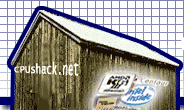


 |
 |
 |
| home | about | pictures | reference | trade | links |
SAN JOSE, CA - OCTOBER 14, 1997 - Forthcoming versions of the AMD-K6(TM) processor will incorporate new AMD-3D(TM) technology that will lead the personal computer industry's move to visual computing and establish a "new world order of alternative Microsoft®, Windows® based platforms," AMD Chairman and CEO W.J. Sanders III said today.
Next year, AMD-3D technology will give us an opportunity to distinguish ourselves from Intel and lead the way to visual computing platforms within the Microsoft Windows standard that deliver a near theater-quality experience," Sanders said in keynote remarks to the 10th annual Microprocessor Forum, the industry's most prestigious technical gathering.
Sanders said the technology will solidify AMD's position as the only company with a realistic opportunity to lead in the development of an alternative platform for Microsoft Windows based computing.
A Superior Multimedia Solution
"In the first half of 1998, we plan to introduce the AMD-K6
3D MMX(TM) Enhanced Processor with initial
clock speeds of 300 megahertz and moving to 350 megahertz,² Sanders said. "This
processor will deliver a more powerful solution for a superior 3D multimedia
experience compared to any x86 processor on the market today."
Sanders also said AMD will enhance the Socket 7 infrastructure, and lead development of a Super 7 platform, that will enable cost-effective consumer migration to visual computing.
"Platforms built on the existing Socket 7 and Super 7 will offer superior performance and better value than competitive offerings through 1998 and into 1999," Sanders said.
The AMD-K6 3D processor uses new proprietary instructions developed by AMD and supported by Microsoft Direct X and leading 3D game developers. The processor will enable accelerated and enhanced graphics with full-featured MPEG-2 video and AC-3 sound.
Sanders said the consumer market, with an ever-increasing demand for a richer, more realistic multimedia experience, is driving the technology for the visual computing platform.
"The consumer market is especially attractive to AMD for another reason," he said. "Given competitive choices, consumers tend to make their purchasing decisions based on value, and this is a criterion that creates a special opportunity for AMD."
Following Sanders' remarks, Greg Favor, AMD-K6 processor chief architect, disclosed technical details of the company's 1998 microprocessor roadmap, including aspects of its 3D technology and mobile platforms and the company's Super 7 Platform initiative to further enhance the Socket 7 infrastructure.
30 Percent World Market Unit Share Is Long-Term Goal
Sanders said AMD-3D technology is central to the company's strategy to gain
market share in 1998 by shipping 15 million processors to the consumer and
commercial desktop and notebook market segments.
"AMD has a superior solution for multimedia, which today is the key to gaining market share," Sanders said. "Our challenge is to ship 15 million units in 1998. If we achieve that goal, we will be well on the way toward our goals of establishing AMD as a credible alternative supplier of Microsoft Windows compatible processors and achieving a 30 percent unit share in 2001."
Sanders noted that in 1999, AMD plans to begin shipping its seventh-generation processor, the AMD-K7(TM) processor. He said that AMD plans for the AMD-K7 processor to be assembled in a module mechanically interchangeable with Intel's single-edge connector -- "Slot 1" -- module and will feature the bus protocols of the Alpha EV-6 processor. The AMD-K7 processor will be capable of clock speeds higher than 500 megahertz.
Open Systems, Open Competition
Sanders said AMD would
continue its close cooperation with business and development partners by
licensing its 3D technology to competitors and third-party vendors, including
chipset and motherboard suppliers and independent software developers.
"AMD will license its 3D technology to competitors," Sanders said. "We believe in open systems and open competition."
Sanders added: "Unlike the monopolist, whose concern is to defend its monopoly by excluding and vanquishing good ideas that originate elsewhere, our strategy is to unleash and capitalize on the creativity and innovation of an entire industry. No one will ever have a monopoly on good ideas. The continuing success of Silicon Valley start-ups is testament to that."
Roadmap Based On 0.25-Micron Process Technology
In
disclosing AMD's 1998 roadmap, Favor said the company's 0.25-micron process will
enable production of AMD-K6 processors with higher speeds and lower power in a
68-square-millimeter die size.
Favor disclosed that AMD-3D technology incorporates a new set of instructions that provide much higher performance in multimedia algorithms enabling "real world" modeling on the desktop and a significant performance boost that is visually striking to the end user running AMD-3D enhanced applications. The new technology also accelerates floating point intensive multimedia operations. The AMD-K6 3D processor will have a transistor count of 9.3 million and a die size of 81 square millimeters.
Socket 7 Price, Performance Advantages Extended
The AMD-K6+ 3D processor, scheduled for introduction in the second
half of 1998, will add an on-chip 256K L2 cache, pushing the new K6 transistor
count to 21.3 million with a die size of 135 square millimeters, smaller than
the original AMD-K6 processor, with 8.8 million transistors. It also will
support an optional L3 cache for enhanced performance, while maintaining Socket
7 compatibility and delivering performance up to 400 megahertz.
Favor said that through AMD's Super 7 Initiative, several vendors, including AMD, will have a 100 MHz frontside bus and Accelerated Graphics Port support during the first half of 1998, enabling Socket 7 L2 cache to speed up by 50 percent. The Super 7 Initiative will enable the Socket 7 infrastructure to scale with higher clock speeds while maintaining a superior cost structure over Slot 1.
Cautionary Statement
This press release contains forward-looking statements about
management's expectations of future performance. Investors are cautioned that
all forward-looking statements involve risks and uncertainties that could cause
actual results to differ materially from current expectations.
The forward-looking statements about the AMD-K6 MMX(TM) Enhanced Processor involve risks and uncertainties that the company's production ramp will fall short of expectations, that production yields will improve, that the company will be able to develop and introduce AMD-K6 processor improvements and new members of the AMD-K86(TM) processor family in a timely fashion, that customer acceptance and demand of the product will continue, that the customer base for the product will continue to expand, that timely development and qualification of 0.25-micron process technology will occur, that customer demand for the product will be less than available production capacity, that new wafer fabrication process technologies will not be developed as rapidly as customers need or demand, and that economic conditions will change and affect demand for microprocessors and other integrated circuits. Investors are urged to consult the risks and uncertainties detailed in the company's reports filed with the Securities and Exchange Commission.
About AMD
AMD is a global supplier of integrated
circuits for the personal and networked computer and communications markets.
AMD produces processors, flash memories, programmable logic devices, and
products for communications and networking applications. Founded in 1969 and
based in Sunnyvale, California, AMD had revenues of $2 billion in 1996. (NYSE:
AMD).